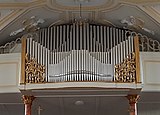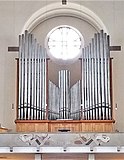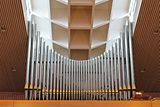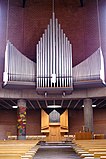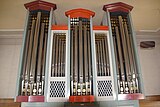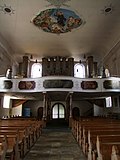Organ building Zeilhuber
The Zeilhuber company is a workshop for organ building located in old towns near Sonthofen in the Allgäu . Since the company was founded by Josef Zeilhuber, over 200 new buildings have been built, including the former main organ for Munich Cathedral in 1957 . The workshop is run in the third generation by Alfons Zeilhuber jun. (* 1965).
Josef Zeilhuber Sr. (1889–1964)
The company founder Josef Zeilhuber sen. comes from Haag in Upper Bavaria and began an apprenticeship as a carpenter. Due to the move of his teacher to the area around Rosenheim, he came to the local organ building company Müller & Hackl. The period from 1908 to 1927 with Otto Mönch in Überlingen on Lake Constance, where he was also responsible for large projects as workshop master from 1914, was formative for his organ builder life . A job reference issued by this company shows great appreciation.
In 1927, Zeilhuber and Johann Bottling as a senior partner in Augsburg - Pfersee founded a company called "Bottling & Zeilhuber Orgel- und Harmoniumbau". In 1927, an organ with nine registers from the Augsburg period went to Lichtenau . The opus 2, an organ with 21 stops for the parish church in Altstädten in the Allgäu , was not made in Augsburg, but in the premises of the Mönch company, with which Zeilhuber still maintained good contacts. The organ intended for old towns was destroyed in a workshop fire in 1928. At the second attempt for this instrument, Zeilhuber no longer traded together with Bottling, but only under the name “Orgelbauanstalt Josef Zeilhuber”. He gave up the company headquarters in Augsburg and settled in old towns after painstakingly convincing the local authorities. From here, Josef Zeilhuber delivered a considerable number of organs to the Swabian and Upper Bavarian regions, which until around 1950 were equipped with a pneumatic cone drawer, and from 1930 on larger instruments also with an electric cone drawer. From 1954, the cone shop only built with electrical controls. The brochures of the early years are committed to the free pipe aesthetic, were often created with the collaboration of architect Hans Miller from Munich and show some creative combinations with baroque elements (e.g. Altusried - St. Blasius or Kempten (Allgäu) - St. Lorenz).
Josef Zeilhuber jun. (1913-1996)
The eldest son Josef Zeilhuber jun. learned the organ building trade from Paul Ott in Göttingen , a pioneer in the revival of mechanical organ building, and from Mönch in Überlingen. After working in his father's company for a few years, he left the company in the late 1940s. In addition to his marriage to Bruckmühl and his artistic ambitions, the main reason was his father's unyielding attitude towards modernizing the company to include grinding shop construction, which Josef jun. had met at Ott. In Bruckmühl he mainly worked as a skilful and art-loving wood sculptor and was only active as an organ builder to a limited extent. Instruments in Albersbach (St. Cross, originally built in 1969 for Vagen, II / 10), Gempfing (St. Vitus, around 1965, II / 20) Kolbermoor (Hl. Trinity, 1969, choir organ II / 8 and main organ II / 23), Massenhausen (Mariä Visitation, use of old parts 1972, II / 12) and Bruckmühl.
Alfons Zeilhuber Sr. (1922-1986)
It was only when the younger son Alfons Zeilhuber sen. At the beginning of the 1960s, the old town company reluctantly turned to the initially electric, and from 1968 mostly mechanical, sliding drawer. Alfons sen. received his training in his father's company, which was followed by an internship in the intonation department at Gieseke. The change was not easy because Josef sen. maintained his romantic style well into old age and in 1957 had equipped the main organ for the Munich Cathedral, comprising almost 80 stops , with a free pipe prospect and an electric cone store. Alfons sen. Headed the company from 1964 until his sudden death in 1986.
Alfons Zeilhuber jun. (* 1965)
After the temporary shutdown, the company is now managed by Alfons Zeilhuber jun. (* 1965) continued. He joined the company as an apprentice in 1986, shortly before his father's death. After executing the pending orders, the company was inactive from 1990 to 1997, as it had no chance of survival without suitable management. Alfons Zeilhuber jun. continued his training with Gerhard Schmid in Kaufbeuren, where he met his wife Christine Albiez, daughter of the Lindau organ builder Winfried Albiez . After his journeyman examination, Alfons jun. 1988/1989 in Austria at Orgelbau Pflüger , Feldkirch, and from 1989 to 1995 at Rieger in Schwarzach together with his wife, who had gained experience there especially in the area of intonation. In 1996 Zeilhuber passed the master's examination at the Federal College for Organ Building in Ludwigsburg and in 1997 he resumed work in old towns with what is now a five-person team.
Organs from the Zeilhuber company (selection)
| year | place | church | image | Organ builder | Manuals | register | Remarks |
|---|---|---|---|---|---|---|---|
| 1934 | Oberstdorf | St. John Baptist | Josef Zeilhuber | III / P | 58 | Fernwerk behind the high altar | |
| 1934 | Lindenberg in the Allgäu | St. Peter and Paul | Josef Zeilhuber | III / P | 55 | Free pipe prospectus | |
| 1935 | Antdorf | St. Peter and Paul | Josef Zeilhuber | II / P | 18th | ||
| 1935 | Starnberg | Mary Help of Christians | Josef Zeilhuber | III / P | 45 | ||
| 1936 | Bad Hindelang | St. Johann | Josef Zeilhuber | III / P | 52 | Use of pipe inventory from the previous organ by Steinmeyer, Fernwerk in the attic of the choir room | |
| 1936 | Kempten | St. Lorenz |

|
Josef Zeilhuber | III / P | 62 | Reconstruction and enlargement of the Walcker organ from 1864 |
| 1948 | Fürstenfeldbruck | Fürstenfeld monastery church | Josef Zeilhuber | II / P | 25th | Choir organ → organ |
|
| 1943-1952 | Altusried | St. Blaise and Alexander | Josef Zeilhuber | III / P | 44 | ||
| 1948 | Munich - Giesing | Queen of Peace | Josef Zeilhuber | III / P | 37 | Partial expansion (originally 54 registers planned); Using numerous older pipe material | |
| 1957 | Munich | woman Church | Josef Zeilhuber | IV / P | 79 | Main organ, today stored in the Valley Organ Center | |
| 1957 | Munich | St. Catherine of Siena | Josef Zeilhuber | II / P | 28 | formerly Andreas organ of the Munich Frauenkirche . 1994 from the Valley Organ Center . |
|
| 1958 | Munich | Mary Queen of Peace | Josef Zeilhuber | III / P | 37 | 1997 expansion | |
| 1962 | Söcking | Ortisei | Josef Zeilhuber | III / P | 31 | ||
| 1964 | Villages | Pilgrimage Church of the Assumption of Mary | Josef Zeilhuber | III / P | 34 | 2013 Expansion by Orgelbau Utz and Orgelbau Weber to 40 registers | |
| 1964 | Munich | Suffering of christ | Josef Zeilhuber | III / P | 39 | Renovated in 2012 by Munich organ builder Johannes Führer | |
| 1970 | regensburg | St. Boniface | Josef Zeilhuber | II / P | 24 | Auxiliary plant down way | |
| 1978 | Kaldorf | St. Andrew | Josef Zeilhuber | II / P | 10 | ||
| 1985 | Sonthofen | St. Michael | Alfons Zeilhuber Sr. | III / P | 43 | neo-baroque disposition | |
| 2002 | Markgröningen | Holy Spirit Hospital |

|
Alfons Zeilhuber jun. | II / P | 26th | |
| 2006 | Möckmühl | St. Kilian | Alfons Zeilhuber jun. | II / P | 26th |
literature
- Christian Kohler: Organs and organ builders in the Allgäu from 1850 to the present. Diploma thesis Augsburg, 2007. Augsburg / Nuremberg University of Music.
Web links
- Website of the organ building company Zeilhuber
- Biographies, descriptions of individual organs in the "Allgäu Orgelbau"

